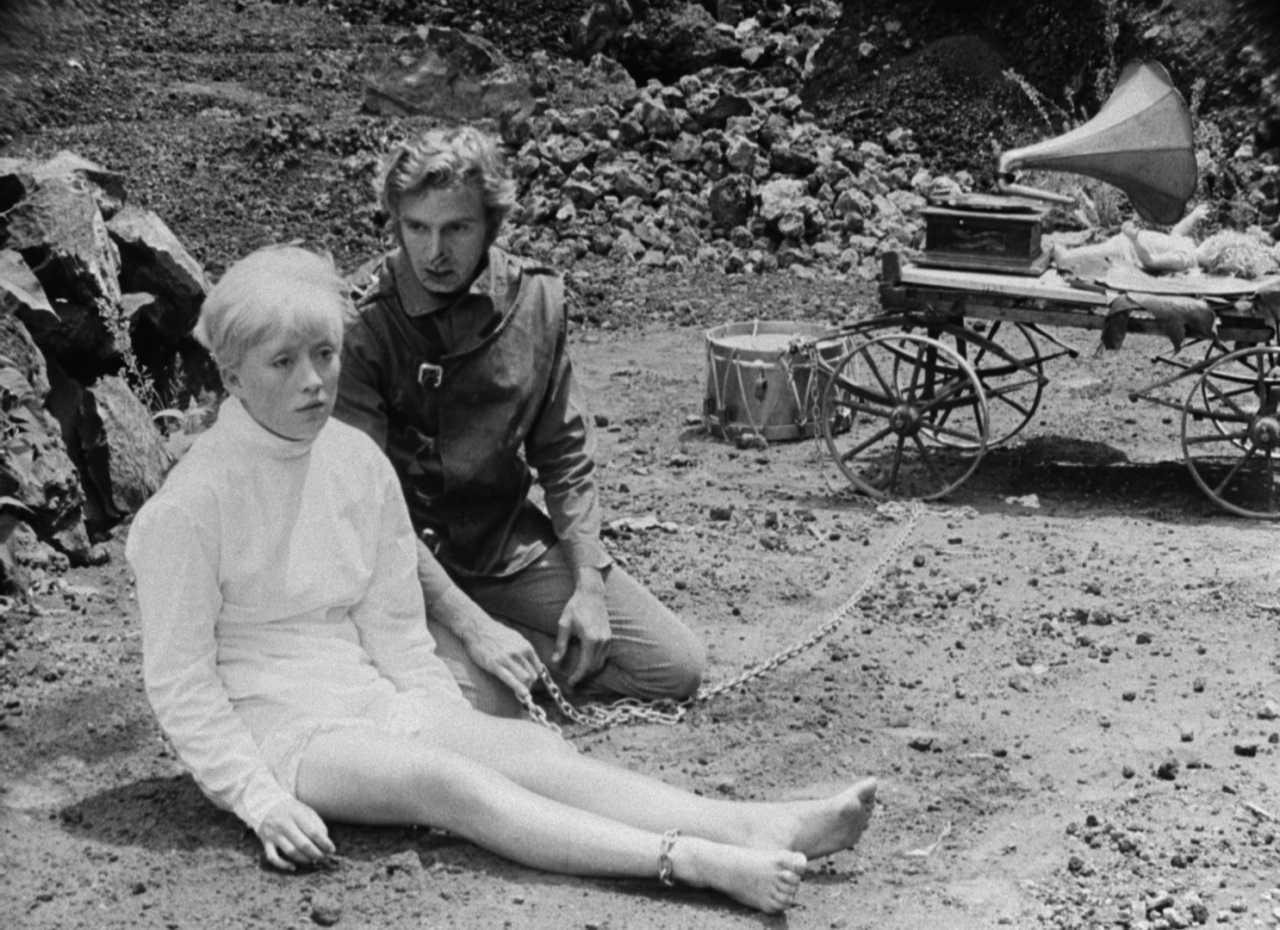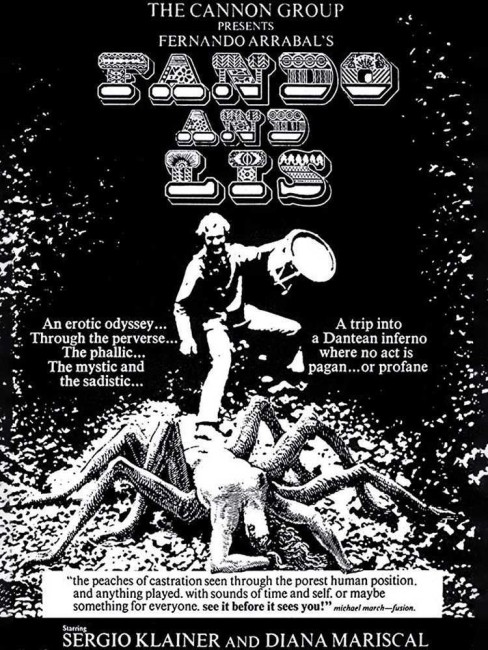(Fando y Lis)
Mexico. 1968.
Crew
Director/Adaptation – Alexandro [Alejandro] Jodorowsky, Screenplay – Fernando Arrabal & Alexandro Jodorowsky, Based on a Play by Fernando Arrabal, Photography (b&w) – Reynoso & Corkidi, Music – Pepe Avila, Hector Morely & Mario Lozua. Production Company – Producciones Panicas.
Cast
Sergio Klainer (Fando), Diana Mariscal (Lis)
Plot
Following the destructions of the cities, all that remains is the mythical city of Tar where all dreams come true and people can live in peace, Fando and his love Lis set out on a quest to find Tar. Her legs are paralysed and so he carries her on his back and then in a cart. Their quest takes them through meetings with various strange people.
Alejandro Jodorowsky is one of the cultiest of cult directors. Jodorowsky gained attention with the hallucinatory madness of El Topo (1970) and The Holy Mountain (1973), which gave him a name as a director steeped in 1960s drug-taking, Eastern mysticism and expanded consciousness. Almost as soon as he gained a following, Jodorowsky began to run into problems. His massively ambitious production of Dune (1965) fell apart – see Jodorowsky’s Dune (2013) for the full story – and works like Tusk (1980) and The Rainbow Thief (1990) failed to be attain proper release or were disowned by Jodorowsky, while other announced projects failed to come about. The only fully completed work he made after 1973 was Santa Sangre (1989). And that was it for 23 years until Jodorowsky suddenly re-emerged again at the age of 84 with The Dance of Reality (2013), followed by Endless Poetry (2016) and the documentary Psychomagic: A Healing Art (2019).
Jodorowsky had formed the Panic Movement in Paris in 1962, along with Fernando Arrabal and Roland Topor. This was designed as a performing troupe to put on a series of surrealist plays and performances that were intended to achieve a transcendental breakthrough in consciousness for audiences through their juxtaposition of shocking and outrageous imagery (an approach that Jodorowsky would later apply as a director). Around the same time, Jodorowsky was dividing his time between Paris and Mexico. In Mexico, he made Fando and Lis based very loosely on what the credits state are only his memory of a play written by Arrabal in 1962. Arrabal later became an acclaimed writer and directed several films of his own, most notedly the extraordinary Viva La Muerte (1971).
Fando and Lis is one of the more obscure films in Alejandro Jodorowsky’s oeuvre. It premiered in Acapulco and there were stories about riots breaking out among audiences (although I am unable to glean from my reading what the riots were about). The film played several international film festivals and then appeared to vanish from circulation thereafter – surprisingly enough, it was not resurrected after Jodorowsky gained a name with El Topo – and was not widely available until a dvd restoration in 2021.
Looking back at it after seeing the works that Jodorowsky has become more famous for, Fando and Lis reads like a student film. You can see the surrealistic juxtapositions and outrageous imagery that would form the core of El Topo only two years later, but it is a work where what Jodorowsky was trying to achieve is still being formed. The early scenes also show a Jodorowsky who is still back in avant garde theatre and what hasn’t quite come in are the Zen pretensions and Carlos Cataneda-mushroom hallucination trippiness that became the essence of El Topo and The Holy Mountain.

The talk about the utopian city of Tar that exists after all other cities have fallen have led some to interpret Fando and Lis as a Post-Holocaust Film. The film’s locations take place amid ruined buildings, junkpiles and empty desert, which is fairly much a standard setting for the genre. The couple on a journey to a fabled city makes one think of the subsequent Glen and Randa (1971), a much more literal post-holocaust film. (In both films, the city of their destination is never reached). However, viewing Fando and Lis as a science-fiction film is an overly literal interpretation – in truth, Jodorowsky is treating these elements more as fable, while the progression of imagery makes Fando and Lis much more of a work of Surrealism.
There is really not much more to the film than the two title characters on a journey in search of the mythical city. Everything plays out as a surrealistic picaresque where the two come across variously:- scenes where graves are dug and people buried in them; a group of people who roll around in mud; a group of old women sit around a table playing cards and gambling with pieces of fruit in tins, while one keeps a handsome younger man as a toy boy; where Fando (Sergio Klainer) is pursued by women throwing cantaloupes at him; where Lis (Diana Mariscal) wakes up on a heap of animal skulls; a doll is slit open to make a vagina and baby snakes are placed inside; while Fando and Lis paint their names on each other and then throw paint about covering themselves and the entire room of an abandoned building.
In some scenes (which one suspects must have been the ones that caused outrage), Sergio Klainer is surrounded by men in drag who then chase him and force him into women’s clothes. Jodorowsky also doesn’t appear to have too high a view of women – Fando variously chains Lis’s ankle to the cart he pushes her around in, handcuffs her up and then kicks her to death, before they appear to be resurrected and run off to enjoy love happily ever after together.
I don’t have a huge patience for this time of filmmaking anymore. It is more akin to going to an art gallery than watching a film, one where you can enjoy the often striking juxtaposition of images and moments of outrage but where it requires an art history degree to be able to interpret the hidden meaning of the symbols. In truth, the only one who knows the meaning of what is going on is Jodorowsky himself and he does nothing to give any indication of what the symbolism means.
Trailer here


